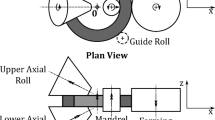Abstract
Steel rings with a circumferential variable cross section, in this case eccentric rings, are used in different fields, i.e. mechanical engineering. Current production routes of eccentric rings have the disadvantages of limited or inflexible geometries, high material waste or inhomogeneous microstructure. The radial-axial ring rolling process is an incremental forming process used to produce seamless rolled steel rings with a near-net shape cross-section. A new approach is to achieve eccentricity by dynamically adjusting the mandrel position during ring rolling. In the past, the basic feasibility of this approach has been demonstrated with model materials such as an oil-clay mixture. In an ongoing project, the feasibility should be demonstrated in an industrial scale ring rolling process with steel rings and the process limits should be investigated. In order to correctly synchronize the infeed of the mandrel with the cross-section variation over the entire process, the rotational position of the ring must be known at any time. Optical geometry detection method chosen in previous work is not easily implementable for ring rolling of hot steel rings due to industrial process conditions. Therefore, this paper describes an approach based on Hall sensors that are suitable for the rough process conditions and determine the ring position on the basis of measured circumferential. Experiments with hot and cold rings were carried out to improve the measured value recording and a calculation for position detection was determined. Furthermore, the described position detection method was tested with FEA-simulations and validated with real experiment.


















Similar content being viewed by others
Data availability
Data available on request from the authors.
References
Allwood J, Tekkaya E, Stanistreet TF (2005) The development of ring rolling technology. Steel Res Int 76:111–120
Lee YS, Lee MW, Park SS, Lee I, Moon YH, Lee MG (2010) Process design by FEM simulation for shape ring rolling of large-sized ring. In: Zienkiewicz OC (ed) Proceedings of the 10th international conference on numerical methods in industrial forming, vol 1252, Issue 1. NUMIFORM 2010. Pohang (Republic of Korea), pp 964–971
de Souza U, Pursell Z, Phillips K, Vaze S (2003) Profile Ringrolling: new techniques have been developed to lower the cost and improve the buy-to-fly ratio of rings and cases in aerospace engines through advances in preform design and processing. Adv Mater Processes 161:35–37
Keeton CR (1988) Ring rolling. In: Metals handbook: volume 14 forming and forging, 9th edn. American Society for Metals, Metals Park, pp 224–268
Pabiszczak S, Myszkowski A, Staniek R, Macyszyn L (2017) Kinematic analysis and design of eccentric rolling transmission. In: ASME (ed) Proceedings of the IMECE 2017 international mechanical engineering congress and exposition, vol 14. Tampa, FL, USA
Industrial Bearings FAG (2003) AG, FAG triple ring eccentric bearings in a Sheetfed Offset Press
Cleaver CJ, Arthington MR, Mortazavi S, Allwood JM (2016) Ring rolling with variable wall thickness. CIRP Ann Manuf Technol 65:281–284
Arthington MR, Havinga J, Duncan SR (2020) Control of ring rolling with variable thickness and curvature. Int J Mater Form 13:161–175. https://doi.org/10.1007/s12289-019-01475-6
Guenther S, Seitz J, Schwich G, Hirt G (2017) Investigation of a composite ring rolling process considering bonding behaviour in FEM and experiment. Procedia Eng 207:1236–1241
Rech R, Müller N, Lamm R, Kirchhoff S (2006) Geometrical laser measurement on large Open die forgings. In: IOM communications limited, London, Institute of Materials, Minerals and Mining. IFM 2006 16th international Forgemasters meeting; 15–19 October 2006, Cutlers’ Hall. IOM Communications Limited, London, Sheffield, UK, pp 635–641
Koppers U (2012) RMS-ring monitoring system. In: Proceedings-ICRF 2012, 1st international conference on ingot casting, rolling and forging 3–7 June 2012, Aachen, Germany, Eurogress, Aachen
Meier H, Briselat J, Hammelmann R, Flick H (2008) Image processing methods for online measurement in radial-axial ring rolling. Paper, Bochum
Briselat J (2013) Prozesssynchrone Vermessung der Ringgeometrie durch Bildverarbeitung während des Radial-Axial Ringwalzens, first., Aufl., Shaker, Herzogenrath
Husmann S (2020) Entwicklung einer automatisierten Stabilisierung des Radial-Axial Ringwalzprozesses durch bildgebende Sensorik. Dissertation, Bochum
Schausberger F, Steinboeck A, Kugi A (2015) Optimization-based estimator for the contour and movement of heavy plates in hot rolling. J Process Control 29:23–32. https://doi.org/10.1016/j.jprocont.2015.03.006
Arthington MR, Cleaver C, Allwood J, Duncan S (2015) Measurement and control of variable geometry during ring rolling. In: IEEE conference on control applications (CCA). IEEE, Sydney, Australia, pp 1448–1454. 21.09.2015–23.09.2015
Arthington MR, Cleaver C, Allwood J, Duncan S (2014) Real-time measurement of ring-rolling geometry using low-cost hardware. In: 2014 UKACC international conference on control (CONTROL). IEEE, Loughborough, UK, pp 603–608. 09.07.2014–11.07.2014
Gellhaus M (1999) Radial-axial ring rolling: technical information
Jenkouk V, Hirt G, Franzke M, Zhang T (2012) Finite element analysis of the ring rolling process with integrated closed-loop control. CIRP Ann Manuf Technol 61:267–270. https://doi.org/10.1016/j.cirp.2012.03.115
Schwich G, Jenkouk V, Hirt G (2016) Realistic modelling of the tool kinematics of radial-axial ring rolling machines in finite element simulation. In: ESAFORM 2016: proceedings of the 19th international, Nantes, France, Author(s), pp 130018
Acknowledgements
The work was funded by the Deutsche Forschungsgemeinschaft (DFG, German Research Foundation)–454751242.
Author information
Authors and Affiliations
Corresponding author
Ethics declarations
Conflict of interest
The authors declare that they have no conflict of interest.
Additional information
Publisher’s Note
Springer Nature remains neutral with regard to jurisdictional claims in published maps and institutional affiliations.
Rights and permissions
Springer Nature or its licensor (e.g. a society or other partner) holds exclusive rights to this article under a publishing agreement with the author(s) or other rightsholder(s); author self-archiving of the accepted manuscript version of this article is solely governed by the terms of such publishing agreement and applicable law.
About this article
Cite this article
Gröper, M., Stergianou, S., Bailly, D. et al. Development of a measurement method for tracking the position of hot steel rings on an industrial radial-axial ring rolling mill. Prod. Eng. Res. Devel. 18, 581–591 (2024). https://doi.org/10.1007/s11740-023-01232-4
Received:
Accepted:
Published:
Issue Date:
DOI: https://doi.org/10.1007/s11740-023-01232-4




